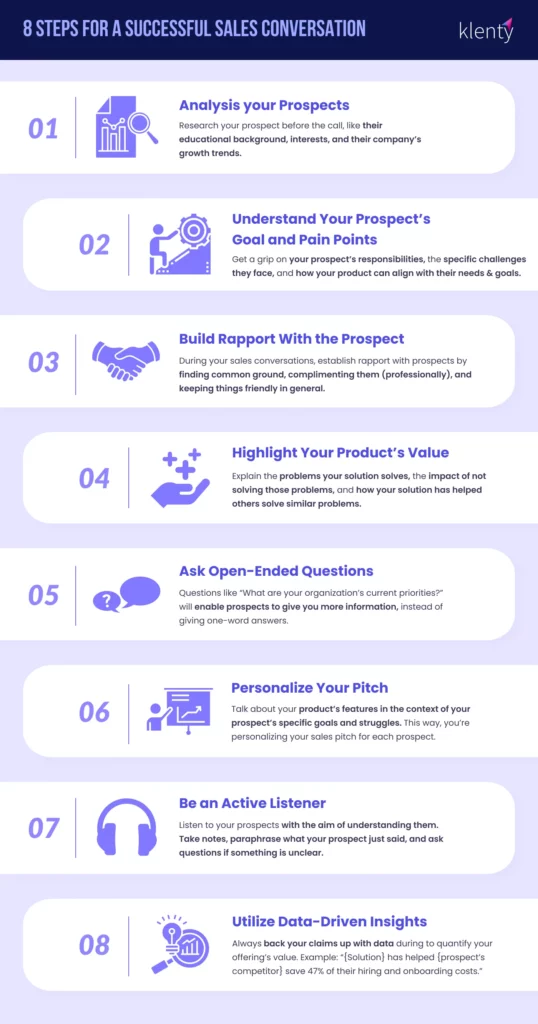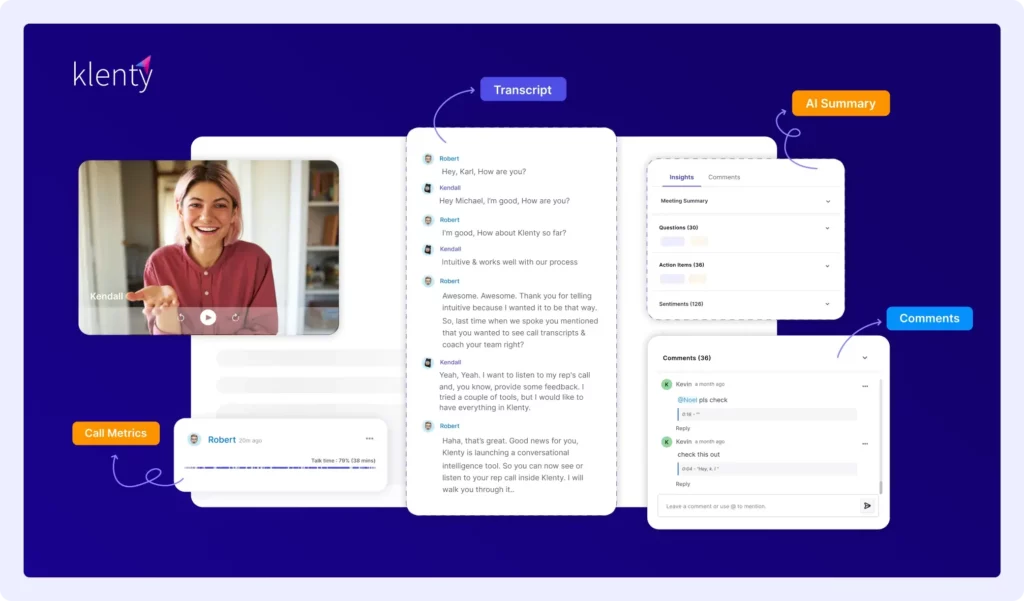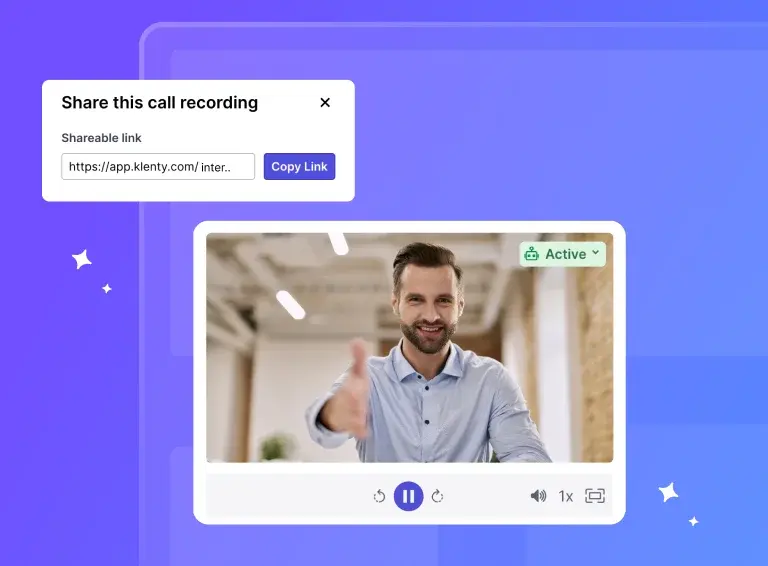You can take sales out of the conversation, but you can’t take the conversation out of sales.
Sales and conversation go hand in hand for the simple reason that conversation helps you understand your prospects better and, in turn, sell better to them.
You learn your prospect’s motivations, goals, and pain points, and everything in between to close the deal.
But, there’s no straitjacket formula for sales conversations. Each conversation is unique because each prospect is one of a kind. So, how do you nail this? Because, let’s face it, there’s no running away from sales conversations. After all, you have meetings to book and quotas to crush!The solution? Having a framework that helps you navigate any sales conversation with ease. In this blog, we’ll equip you with a roadmap and expert tips to achieve just that.
What Is a Sales Conversation?
A sales conversation is a dialogue between a sales professional and a prospect with the ultimate aim of selling a product or service.
It plays a pivotal role in building a relationship of trust between the two participants by educating the latter about the products, as well as addressing their concerns and objections about the offering.
Nail Your Sales Conversations With These 8 Steps
Kylee Lessard from LinkedIn’s marketing department says, “Initiating a conversation with a new prospect can be the hardest part of a sale. Especially if you don’t have a prior relationship. Having a strategy to connect with the prospects you need to reach can help you overcome the communication obstacles that stand in the way of lead generation.”
And we couldn’t agree more. Creating an effective sales call plan for starting a conversation with a stranger, especially in a sales or networking context, can help you feel more confident and alleviate initial anxiety. And so, here are 8 foolproof steps to help your sales conversations score the goal.

1. Analyze Your Prospects
Before the call with your prospect, you need to examine your prospect. Their name, number, and job title aren’t enough if you’re looking to score their sale. And so, the first step to nailing your sales conversation is to conduct some good old research on your prospect. Why? Kyle Coleman, CMO at Clari, gives it to you straight:
“If you don’t take the time to understand a person or company before reaching out, why should they take the time to pay attention to you? You don’t have to be a complete student of their business, but you need to know enough to show them you understand their challenges and can offer some help.”
Dedicating a few minutes to getting to know your prospect better is the difference between a successful sales call and a hang-up. Do your research, let them know you’ve done your homework, and they’ll be more likely to take your call seriously.
If you don’t know how to start your research, Kyle Coleman’s 5x5x5 method will help you out. According to this, you need to spend,
- 5 minutes on research
- 5 minutes on insights, and
- 5 minutes on writing the email, or in this case- on your sales conversation.
That’s all it takes to make your sales conversation go the distance and get your prospect hooked for more.
2. Understand Your Prospect’s Goals and Pain Points
After researching your prospect, it's time to put your findings to use. To do this, build a profile for your prospect and spend some time gaining a deeper understanding of their struggles and motivations. Answer basic questions like:
- What does their day look like?
- What are their responsibilities?
- What specific challenges are they facing in their role?
- How can your product align with their needs and goals?
In other words, get into their shoes and try to think like them. Sean McPheat, CEO of MTD Training, explains,
“It helps you see things from another person's perspective, sympathize with their emotions, and build stronger relationships.”
Doing this will ensure you hit the right topics with your prospects to get them talking and sharing their thoughts with you. Not only that, your prospect will be convinced you know what you’re talking about and be inclined to know more about your offering.
3. Build Rapport With the Prospect
Today, building rapport might as well be the air in the basketball of sales conversation. Without genuine connection, your conversation is going to be a deflated basketball that never reaches the basket of a closed deal.
Why? Because today, your prospect can get all their questions answered on the internet. What prospect is looking for is someone they can trust to guide them to the best solution for their problem. In other words, offering a stellar product at a competitive rate doesn’t cut it anymore; you need to get out there and actually talk to your prospects. Build a relationship with them.
Not only that, you need to offer value beyond your solution.
But how do you go about it? Here are some ways:
- Be Friendly: Think Ted Lasso on this one. A smile and upbeat tone can go a long way in brightening your prospect’s day and making you look like a ray of sunshine. And who doesn’t like that?
- Find Common Ground: Nothing accelerates rapport building like common ground. Maybe you lived in the same city growing up, your children go to the same school, you like the same movies, or you are fans of the same baseball team. Leverage this connection to move from ‘stranger’ to ‘friend’ on your prospect’s tab.
- Be Authentic: You might think, “I don’t have any common ground with this prospect, so I’ll just make something up. How hard is it to presume I like golf?” Let’s stop that destructive train of thought first. If you can’t find anything in common with your prospect, just be genuine and ask them more about something they like. For instance, you could share that you know nothing about golf and ask them whether it is tough and if they have a coach they could recommend. Get them talking about something they like, and you’ll be nurturing a relationship.
- Compliment the Prospect: Flattery is good as long as it's genuine and within professional boundaries. Compliment your prospect if you find something particularly interesting. This could be about their recent LinkedIn post, how well their department did last quarter, etc.
- Adjust the Conversation: No two prospects are the same. This means where one could be a no-nonsense person with a detail-oriented approach, another could be a happy-go-lucky one with a knack for good humor. As a sales rep, it’s on you to recognize this and adjust the sales conversation to better suit your prospect’s communication style.
4. Highlight Your Product’s Value
When it comes to highlighting your product’s value proposition, listing down its amazing features and benefits isn’t going to get you anywhere.
Anthony Natoli, SDR turned AE, suggests sidestepping your product’s features and instead concentrating on:
- The problems your solution solves
- What causes that problem
- The impact of not solving that problem
- How you've helped other people solve that problem
And Anthony is not the only one that subscribes to this view. Troy Gregory, a growth strategist, says you need to concentrate on what your product brings to the table for the prospect in particular. Don’t get lost in the details and forget to highlight how the prospect will benefit from your offering.
The moral of the story? Keep your focus on the prospect. Always.
5. Ask Open-ended Questions
Open-ended questions are ideal if you’re looking to gather as much information as possible because they allow the prospect to interpret the question rather than give a straightforward response. This way, you can get more information than you’re seeking.
Open-ended questions look something like:
- What are your organization’s current priorities?
- What’s keeping you from meeting your goals?
- What else can I do to help you make this decision?
On the other hand, a yes/no question would sound like:
- Are you using {specific} CRM?
- Is there any other question I can answer today?
Don’t get us wrong, both questions have their own benefits, but when it comes to maximizing the effect of your sales call, open-ended conversations help you engage the prospect better by making them sit back and think instead of giving a one-word answer.
Kevin Deldjoui, senior AE at Localize, says, “I want to make sure that what I'm working with is going to fit their needs. So, I have to ask as many questions as possible.”
6. Personalize Your Pitch
Personalization is key. There are no two ways about it. This means doing your homework and relying on points 1 and 2 of this list. Understand your prospect’s pain points, and concentrate on how your product addresses them in particular.
In other words, don’t rattle off your product’s features aimlessly. Instead, lead with those features that tackle your prospect’s challenges. The rest can come late. You need to showcase your product in context to their goals and struggles.
For instance, your product might integrate with leading CRM systems in the market and offer a friendly interface. But mentioning this when your prospect is actually struggling with a tight budget will be counterproductive. Your prospect isn’t interested in other features unless you can do something about the cost.
So, the best way to go about sales conversations is to let your prospect’s individual goals, motivations, pain points, and needs guide you. Personalize each pitch for the prospect, and your deal tally will rise automatically.
7. Be an Active Listener
Contrary to popular belief, sales calls don’t need you to talk, talk, and keep talking. As important, if not more, is listening. In fact, the most successful B2B sales conversations observe a 43:57 talk-to-listen ratio approximately.
But it’s not just about listening. It’s about active listening.
Active listening means being completely engaged with what your prospect is saying. It involves listening to your potential customers with the aim of understanding them rather than responding to them.
Whether it’s a discovery, demo, or negotiation call, actively listening to the prospect is imperative. It helps strengthen your rapport with them and facilitates efficient selling by reducing the time spent on tackling sales objections.
In short, active listening helps bridge the gap between the prospect’s needs and how your offering meets them. Here’s how you can master active listening skills for your next sales conversation:
- Take notes.
- Don’t just hear what your prospect is saying, but listen for the underlying tone in context to what’s been discussed.
- Avoid interrupting your prospect.
- Paraphrase and repeat what your prospect is saying to clarify meaning and understanding.
- Ask additional questions if something is unclear.
8. Utilize Data-Driven Insights
Let’s take an example of two sentences:
“{Solution} can help your organization save big on hiring and onboarding costs by automating repetitive tasks.”
“{Solution} has helped {prospect’s competitor} save as much as 47% of their hiring and onboarding costs by automating repetitive tasks.”
The second one has a better ring to it, right? Your prospect thinks the same. Leverage this to make your sales conversation count.
Data-backed assertions always help cement your offering’s value, whether it’s during pitches, product demos, or even negotiations. This is because they bolster your claims with quantifiable measurements of success. After all, saving big could mean 20% or 60%, depending on perspective.
But that 40% is the difference between your prospect still considering your offering and jumping on board.
3 Mistakes To Avoid in a Sales Conversation
Knowing how to go about anything is just half the work. Knowing what not to do is the other half. In the spirit of this idea, here are 3 common mistakes you should avoid making in a sales conversation:
1. Dominating the Conversation
Your sales call is a conversation at the end of the day. A monologue from your end doesn’t just leave a bad taste in your prospect’s mouth but also hampers your brand’s image in their eyes. It makes the prospect believe you’re not interested in what they have to say and are more focused on hitting your sales quota. Make them feel like just another name on a list, and you’ve lost their business.
And so the first mistake to avoid is to dominate your B2B sales conversation. Dylan Warren, an Enterprise AE, puts it quite well:
“Put more effort into trying to create a great dialog instead of a great monologue (elevator pitch).Being a great listener is key but I feel listening to what prospects and customers mean rather than just what they say is even more key.”
Allowing your prospects to talk will not only give you critical information about them but also make them feel heard and more likely to consider your offering.
2. Offering Unrealistic Promises
You want to hit your sales quota, we get it. But misleading your prospect or even letting them believe an exaggerated view of your offering is not the way.
As a sales representative, it is incumbent on you to ensure you educate your prospect effectively when it comes to what you’re selling. That means ensuring they have the most accurate understanding you can give.
Because while unrealistic promises might allow that one sales call to go smoothly, it will definitely cost you the sale further down the line, or worse, have the prospect come back guns blazing post-sale.
Therefore, the next mistake to avoid is to make unrealistic promises with your prospect.
Here’s our sales conversation tip—give it to them straight, and they’ll be more inclined to take their sales journey forward.
For instance, your prospect might say: “Can you get {solution} up and running over the weekend if I sign off on this today?” Now, saying yes is pretty tempting, but if your product needs time to integrate with a new organization, and a weekend isn’t enough, saying yes is overpromising and setting unrealistic expectations.
Instead, you can sidestep this and respond with: “Nothing would make me happier than you coming on board today. But, for {solution} to deliver on its promises, it needs at least {specific time period} to set up. If we can work around this, I assure you, you’ll not regret it.”
Alternatively, if your prospect wants a feature your product doesn’t offer, do the honorable thing and help them out. Shivani Naveen, a customer success leader, suggests sharing alternative solutions in the market. This does 2 things.
- Firstly, it strengthens your position as a trusted advisor who knows the industry well.
- And secondly, it leaves a good impression on the prospect, convincing them you’re not just looking to hit your quotas but genuinely want to help them.
3. Mishandling Sales Objections
Sales objections handling is part of the game when it comes to sales conversations. Whatever your sales strategy might be, if it doesn’t leave room for your prospect’s objections, it's doing you a disservice.
Sales objections are only natural during a sales call. Your prospects will have a bunch of questions. And it is on you to answer them while acknowledging their individual doubts and misgivings about the sale.
The best way to handle them? Acknowledge, answer, and redirect.
Acknowledge the objection, answer their doubt, and redirect the conversation to your value prop.
For instance, your prospect could say, “We don’t really have the budget for this right now.” Here, saying, “I know you need this; the features are just that good” would be a faux pas. They haven’t questioned your product’s ability to solve the problem; they’ve raised a problem with its price.
A better response would be, “Okay, we could discuss a customized plan for your organization that might fit your budget.” After this, you can steer the conversation toward how you’ve customized a plan for another customer or have them share their budget constraints with you.
How Call IQ Helps You Have Better Sales Conversations
Call IQ is a conversation intelligence tool that transcribes, summarizes, and extracts insights from both video as well as audio sales calls. This sophisticated platform allows sales representatives to get a deeper and more thorough understanding of their own performance as well as the prospects’ priorities.

To give you a sneak peek into the capabilities of this tool, here are some exciting features Call IQ brings to the table:
- Keeps the Team on the Same Page
Call IQ ensures all information about the sales call is accessible to everyone on the sales team. It does this by allowing sales reps to add notes for their sales calls right on the CRM. And so, when the prospect moves further down the funnel, account executives, sales managers, and even customer success managers can access details on the prospect’s entire sales trajectory. Thus, keeping everyone in the loop and, by extension, facilitating a smooth customer journey.
- Helps Identify Key Drivers
Call IQ summarizes each sales call like a pro. By offering 4 types of summaries, each offering targeted information, this tool allows sales reps and managers to extract insights from sales calls just a skim away.
For instance, spotlight summaries, highlight important moments in the call to help sales reps quickly learn what was discussed on the call. Similarly, the Questions Asked, Action Items, and Sentiments Summaries allow you to examine the questions raised, next steps discussed, and prospect emotions picked up on during the call, respectively.
Gaining focused information on these aspects of a sales call empowers reps to understand the prospect’s pulse better and, thereby, how to sell to them better.
- Improves the Quality of Sales Call Conversations
With all that Call IQ provides, sales reps can have more productive sales conversations. How? Well, with convenient note-taking, sales professionals can avoid repeating previously discussed points and pick up right where they left off. The summaries feature allows them to refresh call details while listing down the next course of action without having to devote time to re-listen to past conversations.
And so, sales reps can naturally get back to prospects with enough context to ensure every minute of the sales call is productive.
Resources You'll Love
FAQs
1. How do you have a good sales conversation?
- Analyze your prospects
- Understand their goals and pain points
- Build a rapport with them
- Highlight your solution’s value
- Ask relevant questions
- Personalize your calls
- Listen carefully to your prospect
- Use quantitative data to back up your claims
By including the above points in your sales conversation, you ensure your sales call is beneficial both to you and the prospect.
2. What is an example of sales conversation?
Sales representative: Hi {prospect}, I’m {name} from {company name}. I recently read your LinkedIn post on how you’re struggling to meet {specific} business goal. I think our solution {solution name} could help you here. If you could spare just 5 minutes, I’d love to explain how.
Prospect: Hi {name}, sure, tell me more.
(The conversation continues)





